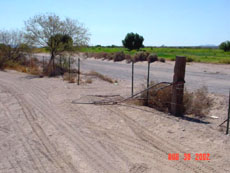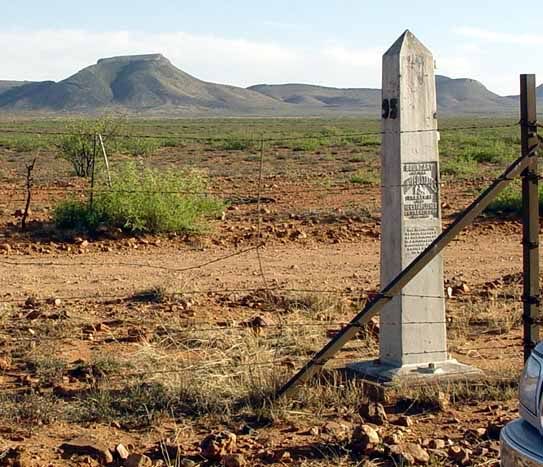
Posted on 12/28/2004 8:28:00 PM PST by JackelopeBreeder
DOUGLAS - The U.S. Border Patrol wants to construct up to 18 miles of new secondary fencing, with most of it being placed about 60 feet north of the existing border wall here and at Naco.
The secondary fencing is included in a wish list of improvements and enhancements the Border Patrol is proposing in the Revised Draft Programmatic Environmental Impact Statement for its Tucson and Yuma sectors.
The report, initially released in October, is now under review.
The additional fencing is just "another enforcement tool that will allow the Border Patrol to patrol both sides of the fence. It will in effect decrease, if not stop, illegal crossing in the areas where it is used. And it will require less manpower to patrol those areas, said Andrea Zortman, a spokeswoman for the agency in Tucson.
The secondary wall also will increase deterrence in the urban areas of Naco and Douglas by allowing agents to patrol the corridor formed between the existing fencing and a second 12-foot fence, increasing the certainty of capturing illegal crossers, she said.
Exactly how much secondary fencing will be used, where it will be located and what type of construction materials will be used are not detailed in the draft of the environmental impact statement.
The request for secondary fencing initially was made in 2001, Zortman said, but things have changed since then. For example, additional manpower, miles of primary fencing and new surveillance equipment all have been installed in the area and have been effective in curbing illegal entries in the urban areas. And for the moment, the Border Patrol's priority is to install still more primary fencing, more lighting, sensors and cameras.
"It's still out there, it's still being studied," Zortman said of the secondary wall plan, "but it's definitely not on the front burner."
For residents living along the border in Douglas and Agua Prieta, Mexico, the debate over the need for additional border fencing is academic. Many said they favor anything that improves security in their neighborhood, whether it's more agents, additional lighting or a secondary border fence.
Things have improved along Agua Prieta's Calle Internacional in the eight years since the Border Patrol replaced the porous chain-link fence with a 12-foot barrier of steel poles, said Enriqueta Martinez, 69, who has lived a stone's throw away from the border for more than 20 years.
The constant traffic of migrants and smugglers has slowed. But at night, Martinez says, she still has to cope with people climbing over the fencing around her yard and up onto her roof where they hide behind the cooler to act as lookouts for the smugglers who continue to work her neighborhood.
"The other day I heard something and came out to see what was happening. I saw a man up on the roof. He told me, 'Don't be scared,' but how can you not be scared, when people are climbing onto your house?" she asked.
Down the street, Maria Elena Olivares, 41, a 25-year resident of Calle Internacional says the existing 12-foot barrier has had little impact on the flow of people through the neighborhood.
"It's the same, people still keep jumping over," she said. "That fence hasn't held back anything. I've watched people cut holes in it and even pull it down in sections.
"I don't think more fencing will work any better, it's just another fence to jump."
Still, she favors any effort to hold back the illegal activity that sometimes spills over from the street into her yard.
It's the same across the border for Fausto Valenzuela and his neighbors living along International Avenue in Douglas.
Eight years ago, there were so many people crossing the border and running through his neighborhood and yard that he'd come to regard home repairs or improvements as pointless.
Valenzuela, 56, who has lived next to the border for 37 years, says he spent much of his time trying to keep up with the damage to his chain-link fence caused as people jumped onto it and then over an adobe wall into his back yard in an effort to elude the Border Patrol.
"Before they put in that fence you couldn't fix anything because they'd break it, and you couldn't leave anything out because they'd take it," said Valenzuela, referring to illegal border crossers. "Those people did a lot of damage," he added.
He supports the construction of a secondary fence in front of his home and would like to see more patrols and more lighting in the area, too.
"It's not as bad now, but people still cross here. It would be good if they could stop it," he said.
Not everyone living in the area is eager to see the additional barrier, saying it will do nothing more than push the smuggling of illegal border crossers into increasingly remote areas beyond the fence where the risk of injury or death is greater, says longtime Douglas Mayor Ray Borane, who is among critics of the plan.
"It's ridiculous to spend more money on a second fence," he said. "The first one didn't work and now they want to put up a secondary fence like they use around prisons. It's not going to solve anything, it's just more eyewash and more money from the taxpayer."
Borane says he isn't surprised that the Douglas residents living nearest the border support the fence and additional enforcement because they have been most affected.
The fence addresses the symptoms and not the cause of the problem, he said.
"They say, 'It keeps traffic out of my yard or my neighborhood,' but then it's another person's back yard," Borane said. "And in the case of Douglas, that means farther out into the countryside."
What about training real coyotes to do the job of scaring intruders? Just a morbid thought.
Ping!
Two of the most disgusting cancers on our society are the drug trade and illegal immigration (to include slave trading). The solution is to erect a gigantic wall with a minefield and armed guards across the entire border and to beef up security patrols by the coast guard for the adjacent bodies of water. That will stem the tide of illegals to something less unreasonable. Either firebomb the hell out of the drug-producing areas of nations like Columbia or just legalize them and allow US businesses to use the free market to run the druglords out of business. Or, do neither one, and keep wondering why the problems don't get solved.
They can use the SeaBee's to build the fence. They can use old beach matting for the fence. That is what they did in San Diego. It helped keep costs down and the Navy is far more productive than union contruction workers.
ping
And what is the honorable Mayor's solution? Amnesty for coyotes? Amnesty for drug runners? How about "tear down that wall"?
Real coyotes are too timid. There are other critters here that make better allies.
A lot of the heavy fence work here has been by Marine Corps Reserve units.

There is very little that I would characterize as honorable about Ray Borane -- not after listening to stories from Mexican-American friends who grew up with him.
Politcally Incorrect I assume.
The Marines are the better half of the Navy.
My in-laws gave thought to moving to Sierra Vista, but the illegals made them think twice. Now they're going to Prescott Valley.
I prefer Claymores. Better kill zone.

Allow me to show off my personal favorite urinal. The real border is just past the monument, so you need some decent hydraulic pressure to do the job right.
i disagree. the fence they put up already is a piece of junk. a decent fence built to professional standards
is needed. seebees work hard but the end product needs
to be the product of modern materials and design, not
juryrigged surplus runway matting.
good pic,
I think I'll [snip] it

You're right. Land mines are far too impersonal and can't distinguish between illegals and innocent cattle and horses.
Disclaimer: Opinions posted on Free Republic are those of the individual posters and do not necessarily represent the opinion of Free Republic or its management. All materials posted herein are protected by copyright law and the exemption for fair use of copyrighted works.